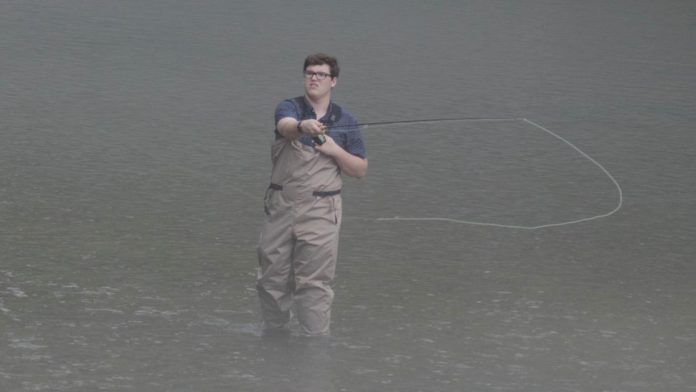BRISTOL — Fishing is already an important part of the Tennessee economy, but there’s plenty of room for growth.
The Tennessee Valley Authority put on an event Tuesday at the South Holston River tailwaters to bring several agencies together and introduce newcomers to fly fishing. It was designed to promote outdoor activities and preserve areas like the South Holston.
Dennis Tumlin, chief customer officer for the State of Tennessee Department of Tourist Development, said that COVID-19 brought people to many of the state’s rural areas and showed how the economic impact of these activities have been overlooked by those in power.
“The pandemic caused a rush of people getting outdoors,” Tumlin said. “There’s been a nice job of retaining those people. It opened the eyes in a challenging time how a county can thrive economically. We saw our rural areas increase when we expected the economics in those counties to decrease.
“Instead, the big cities retracted and it opened our eyes about outdoor recreation.”
According to the Outdoor Industry Association, the outdoor recreation economy generates 106,000 direct jobs and $4.1 billion in wages and salaries in the Volunteer State. It accounts for 2.4 percent of the state’s GDP (gross domestic product).
Tommy Woods, District 1 Commissioner for the Tennessee Fish and Wildlife Commission, points out that outdoors tourism unique to Northeast Tennessee is something that can’t be exported to other places.
“I like to say that tourism is the plant that never closes and moves to a foreign country,” Woods said. “It’s something if we develop it, market it and promote it, it will be here forever. It helps a lot of the economically depressed areas. Some of them don’t have a lot of industry or jobs, but they have beautiful outdoor activities to participate in.
“There’s a push straight from the Governor’s office to develop tourism and market it in the depressed counties.”
For Northeast Tennessee specifically, Tumlin sees an area which can be set apart from other parts of the state.
“You are positioned so well with the world-class trout streams,” said Tumlin, a Chattanooga resident. “You have South Holston Lake, Watauga Lake, the hiking and the mountain bike trails. This area can capitalize so much. Outdoors have driven increases in the economy.”
Tumlin is a fisherman whose passion from the sport goes back to growing up on Lake Chickamauga and spending time with his father. He pointed to a study that 90 percent of those who fish today were introduced to the activity as a kid.
“We love creating opportunities for parents to expose their kids to fishing,” he said. “Studies show that if you’re introduced before 12 years old, the likelihood of you engaging increases drastically.
“In my job with the state, I’ve gotten to understand more of the assets that Tennessee has. You look at world class fisheries like this one and Clinch River. We have trout fisheries, largemouth bass and then catfish in certain lakes around West Tennessee. No matter what experience you’re seeking, we’re about letting people know about family-friendly experiences from trout, to striper to bluegill to crappie to bass.”
An example of the outdoors promoting tourism to the extreme is less than two hours away.
The Pigeon Forge and Gatlinburg area was first marketed for its outdoor activities. Now, it ranks as one of the top tourist destinations in the country.
“The Smoky Mountain National Park is the No. 1 visited park in the nation,” Woods said. “Sevierville, Pigeon Forge and Gatlinburg provide a gateway to that park. While those towns are tourist attractions in themselves, a lot of folks have come to the park and found Sevierville, Pigeon Forge and Gatlinburg.”
A 2020 National Park Service report shows that tourism to the Great Smoky Mountains National Park in 2020 created a cumulative $1.38 billion benefit to the local economy. Visitors to the Smokies spent more than $9.2 million in communities near the park with over a third on lodging and camping, and nearly a quarter on food and beverages. It showed the spending supported 13,942 local jobs.
Both Tumlin and Woods have seen the impact of outdoor activities in other states. Tumlin pointed to Illinois, where much of the economy is driven around hunting with good prices offered to lease farms and year-round food plots.
Woods sees how a rural area in South Dakota he visits in October benefits from pheasant hunting.
“There is more revenue generated in the state of South Dakota on the opening day of pheasant season than any other day,” Woods said. “It’s a large tourist attraction for them. We hope when we have outdoor activities open up, whether it be a nice fishing ramp with state-promoted tournaments, a fishing trail or whatever it may be, these folks travel to our counties and visit our motels, restaurants and shops.”
Woods grew up on Boone Lake, where he loves to fish for stripers with his good friend and guide, Derek Paduch. Woods has also spent a lot of time on Watauga and South Holston Lakes. He’s done some fly fishing, but has done more fishing for trout with a spinner rod.
Bert Carter, the TWRA Regional Fisheries Program Coordinator, prefers fly fishing to being on a lake. For him, it offers both solitude and a challenge that combines different outdoor activities.
“I really to fish in, like, the mountain streams,” he said. “The tailwaters are great also, but I like the challenge of hiking up the streams in the mountains and fishing for wild trout. They’re not very big, but the challenge of it is like the combination of hunting and fishing. You have to be stealthy because those fish are extremely spooky.”
Credit: Source link































